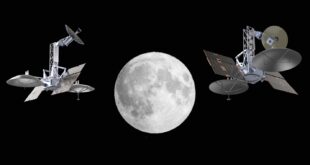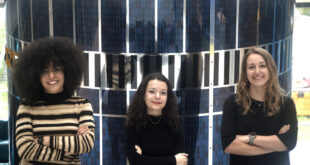by Christophe Bosquillon

There’s been no shortage of recent attempts at clarifying what the problems are with the definitions of success or failure for a Moon mission (see for example Jeff Foust’s several comprehensive analyses and Samuel Nathan Richards’ clarification of Moon landing scenarios). Bearing in mind the pressure applied on CEOs, leadership, and crews of many lunar-aiming venture businesses, and knowing how challenging is to land on the Moon, it is nevertheless important for the insiders of the sector to develop considerations worthy of lunar stakeholders as they sort out their concerns.
The First Report Is Usually Wrong
Colonel Mickey Addison said it best: “The first reports aren’t usually wrong because the people reporting the news are trying to get it wrong. The first reports are usually wrong because in fast-moving situations it takes an enormous amount of skill and patience to sort through to find out what’s really going on.” Furthermore, as “everyone expects a little chaos in an emergency situation”, you need to “learn quickly how to sort ‘possible’ from ‘probable’ and ‘true’ from ‘false’.”
Not crashing doesn’t automatically mean soft-landing.
This is something that we should all keep in mind, now that we are facing a sequence of landings one after the other from all over the world. America is back, re-discovering how to get to the Moon, but it’s not alone this time, and different cultures have different ways of defining, acknowledging, and dealing with success vs failure. Another thing that is different from the Apollo era is the presence of social media. It seems strange for primary stakeholders to report institutional and commercial success directly on social media, only to backpedal a day or two later to announce what really happened: the “true facts” with their expected cortege of mishaps and setbacks. That is not merely a media problem, it is an institutional and somewhat “post-truth” cultural problem.
Fair enough lunar landing grades
Not crashing doesn’t automatically mean soft-landing. Let’s try a fair enough grading of recent Moon missions. The latest Chinese Moon landings qualify as soft. So does India’s Chandrayaan-3 mission. At the other end of the spectrum, the Roscosmos Luna-25 lander crashed onto the Moon’s surface (August 2023) while manoeuvring to position for a lunar south pole landing two days later. Back in January 2024, Astrobotic Peregrine Mission 1 made it into cislunar space, activated payloads, then had to turn back and burn re-entering into Earth’s atmosphere. Japan’s ispace Hakuto-R Mission 1 did fulfil 8 out of 10 self-defined success stages, but it missed “success 9” by crashing on the Moon’s surface, due to a distance evaluation software glitch during descent. Finally, in the grey area of “not quite a soft-landing, but not a failure either”, we have Japan’s JAXA SLIM and US’ Intuitive Machines IM-1’s Odysseus: a few things broke, but active payloads were functional long enough to send data, even if it all ended prematurely due to solar orientation and depleted batteries issues.
Expecting that “Soft” and “Hard” will remain in usage, we nonetheless suggest the need to integrate soft and hard with some nuances:
+ Grade A: Soft landing on lunar surface, instruments/payloads nominally functional (China, India)
+ Grade B: Soft landing on lunar surface, some issues with instruments/payloads (no example yet)
+ Grade C: Rocky landing: badly positioned, payloads partly functional (JAXA SLIM, IM-1 Odysseus)
+ Grade D: Hard-landing upon nominal descent with the lander and/or payload’s destruction (Hakuto-R-1)
+ Grade F: Failure to reach nominal descent to the Moon
The critical factor: precision landing
Grades A, B, and C could be refined with criteria such as the degree of precision in lunar landing, a critical factor. Looking at it carefully, JAXA SLIM is a mission that defined precision landing within less than 100 meters as a criterion of success, and clearly fulfilled that objective. Intuitive Machines’ Mission 1 Odysseus missed the mark by about 1.5 kilometers. But we should bear in mind that at some point, landers will need to land on pads with an accuracy of one meter (not a hundred, not even ten meters), otherwise they may tip over or crash into lunar facilities. Obviously, we’re not there yet.
Cislunar propellant depots and Lunar Gateway
Once the Lunar Gateway operates, and propellant depots in Earth orbit and cislunar space support lunar missions, there will be more complex situations to grade. Grading lunar missions will be linked to how a spacecraft and its payload will journey across a given space transportation architecture. It sounds reasonable to anticipate that by the mid-2030s, current baby steps will be left behind, and some form of qualitative and quantitative mission architecture rigorous grading, based on norms and standards, should replace current unregulated trends of adamant success claims and mitigated failure excuses.
Cultural context and economic-political pressure
In order to understand if a mission is a “success”, and what “success” means, we need to take into account several cultural factors that overlap with geopolitical and financial interests. In other words, until we have international and agreed standards to grade Moon landings, we should assume that what a country declares “a success” might be considered a failure in another nation, depending on local communication techniques and the financial and political backstory. The geopolitical pressure is evident when NASA has to declare a success for the first US return to the Moon after 50+ years. In contrast, Japan is keen on avoiding geopolitical hype and deals with lunar missions rather differently, aka by focusing on rigorous technical achievements that will position JAXA, the private sector, and the whole Japanese ecosystem among the most reliable partners for Artemis.
Right now what is deemed “commercial” is more like a form of “Research for Business”
Financial pressure is strong because commercial sector CEOs and leadership need to maintain credibility with a series of stakeholders (government anchor customers and funders, VC/private equity investors, the markets and retail investors etc.). Lunar business is not for faint-of-heart investors, either institutional, private equity, or retail. Cislunar transportation missions combined with in-situ resource utilization-oriented lunar activities risk profiles are somewhat comparable to terrestrial critical infrastructures, mining, and oil & gas projects in harsh environments. That suggests involving, past the short-term speculation stage, longer-term project financing models and fit-for-purpose stakeholders, that evolve across a sustainable project lifeline risk profile. Furthermore, on the Moon, there are still major Technology Readiness Level (TRL) issues to solve: it isn’t entirely clear that investors get that simple timeline constraint right.
If there is such a thing as a “lunar (market) economy,” let’s reckon with the fact that we are in a rather early phase. NASA’s CLPS program (pronounced “kleeps”) which stands for Commercial Lunar Payload Services is a robust step toward developing the market segment of “Science-as-a-Service”, but right now what is deemed “commercial” is more like a form of “Research for Business” contracted to the private sector by government as “anchor customers.” That is not really “commercial” yet, and the question is more like how and when a truly “commercial” lunar market economy could materialize.
Safe and sustainable lunar activities
It’s not too early however to start building the right incentives for lunar stakeholders, starting with the government, the private sector, and investors, to develop lunar activities in ways that don’t make a mess of the Moon. In that sense, the recent announcement by UNOOSA Director Aarti Holla-Maini indicates a move in in the right direction: the Committee on the Peaceful Uses of Outer Space (COPUOS) is taking one step closer to setting up an Action Team on Lunar Activities Consultation (ATLAC). Established NGOs such as the Global Expert Group on Sustainable Lunar Activities (GEGSLA) and more recently the Lunar Policy Platform have developed frameworks to tackle such issues.
The only sure thing for now is that a statistically inevitable rate of mission failures will sprinkle the lunar surface with crashed landers and payloads. Who will take responsibility and pay to remove or recycle their Moon trash? Therefore, rather than adamantly bragging about lunar victory after tripping over, breaking legs, and missing out on solar cells reloading, simply not making a mess of the Moon might be a preferable priority, putting all major space powers under the same pressure to clean up their act. A universal definition, enforceable for all, of how actual and honourable “success” is should be construed. Evidently, that might prove much harder than even the harshest Moon mission.

Christophe Bosquillon has a diverse professional background, having operated globally with a focus on the Indo-Pacific region. His experiences in Japan, the Koreas, Taiwan, China, ASEAN, India, Russia, and Australia have given him a deep understanding of the multipolar realpolitik of our world under the Pax Americana. With a background in engineering, trade, and foreign direct investment in industries relevant to Space Resource Utilization (SRU), such as mining, transportation, energy, manufacturing, agrifood, environment, and digitalization, Chris is committed to developing SRU value chains that benefit the Earth. As an executive, owner, writer, and founder of Autonomous Space Futures Ltd, Chris has extensive experience in collaborative policy crafting and works to develop space business and governance models relevant to society. He is a member of NGOs that provide input to the United Nations Committee on the Peaceful Uses of Outer Space (UNCOPUOS) legal subcommittee Working Group on Space Resources. Chris contributes to regulatory clarity on appropriation, priority, sustainability, and sharing in a way that balances national interests with civil society inclusion, provided a transparent due process is followed. When advocating for access to technology and space for the Global South, Chris believes that emerging space powers’ participation in space markets must be commensurate with their interest and involvement in international space politics. He believes that their ability to develop sovereign domestic capabilities with spillover potential is also essential. Chris is keen on ‘Peace Through Strength’ diplomacy and deterrence-based security as enablers of secure space access. He supports sovereign cislunar space situational awareness as mandatory for freedom of circulation in the space domain and deconflicted cooperation on the Moon.
 SpaceWatch.Global An independent perspective on space
SpaceWatch.Global An independent perspective on space




